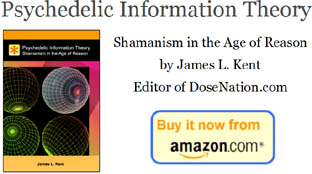I spent this weekend at the “Psychedelic Science in the 21st Century” conference in San Jose. Here is the brain-dump of my experience.
I flew in the Friday morning for opening ceremonies and the first thing I did was go say hi to Jon Hanna, Earth and Fire, and all the lovely people at the Erowid table. Alex and Allyson Grey were passing by so I stopped to say hello and ask permission to use one of Alex’s paintings in Psychedelic Information Theory. Alex was in good spirits despite still being in a white plastic turtle-shell for mending his broken back; it looked like he was sporting high-impact body armor under his suit jacket. Alex and Allyson were delighted with the review galley of the book and agreed to let me use the image. Score. [NOTE: Permission to reprint the image was subsequently revoked via e-mail. FAIL.]
Shortly after that I ran into J.R. Irvin from GnosticMedia.com and skimmed through a copy of his book: The Holy Mushroom Evidence of Mushrooms in Judeo-Christianity. It struck me as something unique so I grabbed it. We talked about Andy Letcher and Shroom, and then digressed into discussions about his plans to do an expose on Wasson’s ties to the CIA, JP Morgan, and the Kennedy assassination. This reminded me of territory that was covered in Dan Russell’s Drug War: Covert Money, Power, and Policy in America’s War on Drugs, an amazing text but in low circulation and hard to find, even at a conference with three vendors and at least a dozen tables stacked with drug books. Many conjectures were forwarded.
About that time I ran into Stephan Beyer, author of Singing to the Plants. We had been meaning to do an interview but it fell apart due to scheduling issues, and we agreed to get some time together later. Wandering around I also had time to meet and have a short chat with Charles Shaw of Exile Nation. I said hi to Rick Doblin and thanked him for putting on such a great event. I talked to Ethan Nadelmann from the Drug Policy Alliance about the wave of media appearances when the legalization issue was stuck in the echo chamber in January. I wondered what the cycle was for those kinds of swells in media attention; Nadelmann admitted it happened every so often, but the last one was certainly the biggest. Conjectures on various legalization initiatives were forwarded.
I also ran into Bruce Eisner; James Oroc, author of Tryptamine Palace; Charles Hayes, author of Tripping; and got to say hi to Robert Tindall, author of The Jaguar that Roams the Mind, sporting his cute baby girl in a snuggy on his chest. I also ran into Evan, the owner and operator of The Teleomorph, as well as Dave Nichols, Charlie Grob, and many old friends I only see at events like this. While hanging out at the Erowid table I met many new people of exceptional quality, all brimming with new hope now that psychedelic research and science was alive again. Almost everybody I spoke to had a book or a project or a study or a practice or something they were doing to advance the field. It appeared that we had weathered the dark period and were officially in the future. Amazing.
I did so much wandering around and chatting that I got to see only bits and pieces of most presentations, but I made a point to see Andrew Weil. Compared to the academics in the line-up, Weil is a world-class speaker and blew the house down with stories of auto-immune transformation and spontaneous healing of cat allergies on LSD, as well as insights into the marijuana movement and how he longed for the day when a designer cannabinoid product like Sativex might be made available in the US. It is no wonder he is the brand name for holistic medicine.
Feeling inspired I went to the tea tent in a funky fenced-off smoking area behind the performance hall. This was a little piece of Burning Man playa transported to the cracked asphalt of the overflow parking lot of the San Jose Airport Holiday Inn. The tea-hut chill-out room was the perfect antidote to all the academic talk going on in the halls. I spent a good chunk of time here. Later that day I made it to Stephan Beyer’s presentation on ayahuasca hallucination, and was interested in the seamless presentation of formal objects he perceived, like lucid dreams, that would disappear into background noise when he tried to touch them, but reappeared once he pulled his hand away. He used those experiences to discuss how the brain tests the boundaries of visual space to decide what is real, what is missing, and what needs to be filled in, and how this applied to ayahuasca, lucid dreaming, and hallucinations caused by partial blindness and macular degeneration. Benny Shannon, author of Antipodes of the Mind, was also supposed to speak on ayahuasca but was a no-show.
Sometime that morning I ran into Rak Razam of The Journeybook and Aya: A Shamanic Odessey. We talked a bit about the Australian festival scene, dominated by Rainbow Serpent in January, originally a trance festival that has evolved to include a rock, dub, and folk scene emerging along the edges. When I asked him what the research chemical scene was like he admitted that there were probably more people making new things than taking new things, and that it was only popular with a small crowd. I marveled at how much traveling and promotion he has been doing lately; the man is a psychedelic gadfly. Later at the Erowid table beautiful women came looking for him with luggage and snack bars. “If you see Rak remind him to eat food,” one of them asked, handing me a granola bar.
I also ran into an old friend who is a chemist, now working for a chemical supply company making 18-MD, a synthetic form of ibogaine used to treat addiction. It is apparently a 24-step synthesis. Some dirty pictures were drawn. Later on I ran into another old friend who just synthesized a novel diterpine from the ground-up as part of his graduate thesis, a 15-to-17 step process. More dirty pictures were drawn. Later that night at the reception in the Erowid hospitality suite (decorated with amazing psychedelic art by Jason Tucker and others) there was a collection of chemists including Alexander Shulgin, Nicholas Sand (of Orange Sunshine fame), and Trout, one of the most notorious botanical extract chemists and assayers of all time and author of Some Simple Tryptamines. On display for everyone to review was the new Shulgin Index, a chemical index of psychoactive phenethylamines modeled after the Merck index. The Shulgin documentary Dirty Pictures was also showing in town, although I never made it to the screenings.
My presentation, “The Mechanics of Hallucination: Nonlinear Destabilization in Perceptual Systems,” was on Saturday morning. I presented in one of the secondary rooms so the house was packed. Despite some technical issues the presentation went well, and I introduced the paradigm of psychedelics as catalysts for destabilizing linear frame perception and creating nonlinear states of complex consciousness. Even though one critical slide turned up missing and PowerPoint would not play any of my embedded videos, I improvised with the camera operator and did an impromptu performance to demonstrate recursive nonlinear frame stacking in a simple video feedback loop. As I spontaneously produced fractal hallucinations against the wall there were audible gasps and murmurs. I think this blew some minds.
Later that day I ran into a chemist who shared some research findings on the nonlinear pitch transposition caused by DiPT in audio networks. It seems that for many people DiPT causes them to hear sounds modulated down an entire octave or more, but his research also revealed that for musicians and people with perfect pitch this effect was less noticeable. There was also some speculation of the differing effects of hallucinogens on people with tonal languages, such as the Chinese. Many conjectures were forwarded. Later on in the tea tent I ran into a co-organizer of a hacker space and used the synchronicity to pick his brain about various ideas I’ve had for an open source toolkit to turn the internet into a self-aware perceptual system, and how such a toolkit might be best deployed. Many conjectures were forwarded. Doug Engelbart’s name was invoked more than once in my encounters.
After the master plan to wake up the internet was hatched, I ran into Steve Beyer and decided it was a good time to talk. We circled in the darkness outside the tea tent for almost an hour discussing the less savory aspects of ayahuasca shamanism, including phlegm, magical darts, attack sorcery, shamanic attitudes towards the West, ayahuasca tourism, the influence of the Catholic Church, shamanic personalities, differing shamanic ontologies, and so on. We both agreed that there are some fairly dark and sinister aspects to psychedelic practice, that psychedelics can either help you or destroy you, and these aspects are rarely (meaning never) discussed at feel-good psychedelic conferences focused on therapy and transpersonal awareness. He told me that local Peruvian people sought out the shaman for healing physical ailments, and that only tourists sought spiritual healing, and that Mestizo shamen were surprised at the number of gringos who were abused as children. He called it nothing less than a spiritual affliction of our people. Information was traded but few conjectures were forwarded, other than Beyer’s vision that I would find myself on a plane to Peru sometime in the near future.
On Sunday morning I spent an hour talking with Trout about the frustrations and freedoms of being a self-funded amateur scientist in an underground field. Both of us expressed skepticism that academia had the proper tools for covering such a multidisciplinary subject – chemistry, pharmacology, botany, biology, biosynthesis, neuroscience, cognition, anatomy, perception, consciousness, psychology, anthropology, sociology, spirituality, and so on – and that specialized academic tracks can make people blind to seeing new pathways to information in this field. Being on the outside of academia gives us freedom and underground credibility, but little formal recognition. Trout admitted that he constantly seeks novelty or quickly burns out, and could never commit to a single academic track. I feel the same way. We are both information junkies in our field, much like the Erowids, who self-funded and produced an enterprise-level web information portal from scratch. And why? Because we are passionate about resolving ambiguities about psychedelics, and there is no other way to get it done than to do it ourselves. Many years ago, when I was lamenting the dearth of a general psychedelic science graduate tract, a man told me that he thought there was still a great deal to be accomplished by amateurs in this field. That man was Bob Wallace. At times during this event I swear I saw the ghost of Bob Wallace milling about.






















Thanks for the rundown--love it! You bring up some VERY interesting things, esp. regarding DiPT. I'd never considered how it might impact people used to different languages.
Perhaps it was telling me to stay away from music--my one taste of the stuff was at ego-death-via-sonic-vibration level...and women sounded like men; men sounded like machines.
Keep up the great work, old friend!
Rev.
Paul Krassner shares his Trip with Groucho Marx, I track down a Divinity student from Tim Leary’s Miracle of Good Friday psychedelic Tests……New interview I did with Ram Dass….and more..all posted on-line at youtube link…plz share this
thanks
Link: Part One
[link]
A few of the things I took away from the conference:
At the opening session, I was suddenly struck by the fact that there are over 1000 people sitting here with the same (or at least similar) dream(s).
I heard it expressed several times that Westerners having ayahuasca experiences could really benefit from integration work (talk therapy type sessions after ceremonies).
It is a huge challenge to separate set and setting from substance, experimentally speaking.
Many thanks to all of the beautiful souls who attended this event. It was the conversations in between presentations that really completed the experience for me.
Bonus points for the Hofstadter slides, btw.
Other than Bob Wallace, of course. That man is still missed :(
I posted some of my impressions on Hip Forums, generating a huge yawn. Looking forward to exploring this site.
The comments posted here do not reflect the views of the owners of this site.